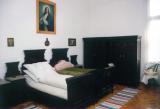2024. April 19. Friday
The Self-government of the Town of Komló József Attila Town Library and Museum Collection - Komló

|
Address: 7300, Komló Városház tér 1.
Phone number: (72) 481-071
E-mail: komloikonyvtar@gmail.com
Opening hours: Tue, Fri 12-16, Wed 13-17, Thu 9-13, Sat 8-12
|
The founder of the Komló Museum - József Kutnyánszky - arrived to Komló in 1933 to take up his job at the notary's office. After a year spent in Sásd he again started work as a clerk in Komló in 1938. From 1942 he started work as an assistant notary. It was then when the thought of qualifying Komló as a town first occoured to him, but the second World War interfered with the accomplishment.
Later he became chief notary of Pécsvárad region, and when he was present at the civil engeneering works of the mine shaft called Kossuth II., he realized that "the lifestyle of the peasants in Komló has come to an end".
In 1950 József Kutnyánszky became chief official of Mecsek Coalmines National Company. He was giving much assistance to Dr. András Babics who was at the time researching the history of coal mining in Komló. They used to talk much about the sed end of peasant life in the region. He was told for the first time to found a museum.
So the challenge was given, and as time was passing by, and the old village was gradually fading away, József Kutnyánszky set out to work.
The case of the museum was discussed by the council in January 1954. On 1st March József Kutnyánszky was assigned to lead the work of museologic collection. His work was assisted by the Coal Mine Trust of Komló, National Geological Institute, Gyula Klausz, István Kovács, dr. György Wein, Árpád Léda, dr. László Rihmer, dr. János Dombay, Zoltán Vass.
The first exhibition was opened on 3rd September 1955 in the Zrínyi Cultural House. József Kutnyánszky placed an emphasis on the collection work of minerals and fossils on the one hand, and region history on the other Léda Árpád, dr. Rihmer László, dr. Dombay János, Vass Zoltán.
Relics of agriculture, peasent lifestyle and mining were placed into the historical collection.
József Kutnyánszky had been thinking of the establishment of a library with periodicals and trade papers. He had also planned to collect photographs.
The result of the work of 22 years are 3159 items, 39 kinds of periodicals, 813 books and 813 photographs.
This work was continued by András Cserdi in the May the 1st Culture House, and later the third museum director, dr. Gyula Erdődy moved the collectiom into its present place.
The collection was moved in 1992. Under the title of "The invisible museum", the local paper gave a foretaste of the permanent exhibition to be formed. The socalled Thinkers Club invited famous performers, and the people were preparing for the opening of the new museum under 1 Városház Square.
In order to raise interest regarding the museum that was at long last moved to a wothy place, the local group of Regions Ages Museums, the Komló paper and the workers of the museum started off a series of games concerning regional history.
The permanennt exhibition still seen today was opened by president Árpád Göncz on 2nd September 1993. "I am proud to be the first to write on the empty pages of our visitor's book, and wish succesful weekdays and marry celebrations to this town and the museum" - he said.
Later he became chief notary of Pécsvárad region, and when he was present at the civil engeneering works of the mine shaft called Kossuth II., he realized that "the lifestyle of the peasants in Komló has come to an end".
In 1950 József Kutnyánszky became chief official of Mecsek Coalmines National Company. He was giving much assistance to Dr. András Babics who was at the time researching the history of coal mining in Komló. They used to talk much about the sed end of peasant life in the region. He was told for the first time to found a museum.
So the challenge was given, and as time was passing by, and the old village was gradually fading away, József Kutnyánszky set out to work.
The case of the museum was discussed by the council in January 1954. On 1st March József Kutnyánszky was assigned to lead the work of museologic collection. His work was assisted by the Coal Mine Trust of Komló, National Geological Institute, Gyula Klausz, István Kovács, dr. György Wein, Árpád Léda, dr. László Rihmer, dr. János Dombay, Zoltán Vass.
The first exhibition was opened on 3rd September 1955 in the Zrínyi Cultural House. József Kutnyánszky placed an emphasis on the collection work of minerals and fossils on the one hand, and region history on the other Léda Árpád, dr. Rihmer László, dr. Dombay János, Vass Zoltán.
Relics of agriculture, peasent lifestyle and mining were placed into the historical collection.
József Kutnyánszky had been thinking of the establishment of a library with periodicals and trade papers. He had also planned to collect photographs.
The result of the work of 22 years are 3159 items, 39 kinds of periodicals, 813 books and 813 photographs.
This work was continued by András Cserdi in the May the 1st Culture House, and later the third museum director, dr. Gyula Erdődy moved the collectiom into its present place.
The collection was moved in 1992. Under the title of "The invisible museum", the local paper gave a foretaste of the permanent exhibition to be formed. The socalled Thinkers Club invited famous performers, and the people were preparing for the opening of the new museum under 1 Városház Square.
In order to raise interest regarding the museum that was at long last moved to a wothy place, the local group of Regions Ages Museums, the Komló paper and the workers of the museum started off a series of games concerning regional history.
The permanennt exhibition still seen today was opened by president Árpád Göncz on 2nd September 1993. "I am proud to be the first to write on the empty pages of our visitor's book, and wish succesful weekdays and marry celebrations to this town and the museum" - he said.
